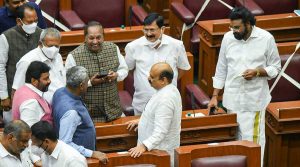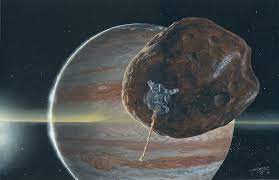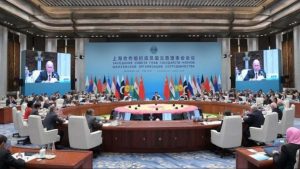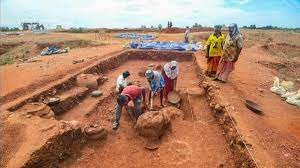Today Current Affairs: 16th May 2022 for UPSC IAS exams, State PSC exams, SSC CGL, State SSC, RRB, Railways, Banking Exam & IBPS, etc
Table of Contents
Karnataka’s Anti-Conversion Bill:

Karnataka state government has decided to take the Ordinance route to get clearance for the Karnataka Protection of Right to Freedom of Religion Bill, 2021.
- The Bill, which was adopted by the Karnataka Legislative Assembly in its special session in December 2021, is yet to be introduced in the Legislative Council.
Highlights of the Karnataka Protection of Right to Freedom of Religion Bill, 2021:
- Any person found guilty of unlawfully converting another person will face a minimum jail term of three to five years and a fine of Rs 25,000.
- If the person ‘unlawfully converted’ is either a minor or a woman or belongs to the Scheduled Castes or Scheduled Tribes, the punishment is more — a minimum sentence of three years and a maximum of ten years imprisonment, and Rs 50,000 fine.
- In cases of ‘mass conversion’, the accused person can face three to ten years in prison and a fine of Rs 1 lakh.
- An appropriate court will order the accused person to pay compensation to the “victim of conversion and this amount can go up to Rs 5 lakh, and must be paid by the accused over and above the fine under the law.
- In case someone wants to convert to another religion voluntarily, there is a lengthy process in place and this applies to inter-faith marriages too.
Amalthea : Jupiter’s Satellites

According to recent findings, Amalthea appears to radiate out more heat than it receives from the sun, which NASA suggests may be due to Jupiter’s magnetic field or from tidal stresses.
- Amalthea is tidally locked to Jupiter in synchronous rotation — it always aligns with the planet along its long axis.
- The moon Amalthea is one of Jupiter’s 53 named satellites; it was the first to be discovered after the four Galilean moons, and it is the fifth-largest overall.
- In terms of proximity to Jupiter, Amalthea is the planet’s third moon — it takes just 12 hours to make a full orbit.
- Amalthea also contributes to one of the Gossamer Rings of Jupiter — the Amalthea Gossamer Ring — which is the faint innermost Gossamer ring of the planet. The Gossamer Rings are outside the main Jovian ring.
- Only two missions have visited Amalthea: Voyager and Galileo. Both the Voyager 1 and Voyager 2 spacecraft photographed the Jovian moon during their flybys in 1979.
Shanghai Cooperation Organisation’s Regional Anti-Terror Structure Meeting:

Counterterrorism teams from Russia, China, Pakistan and Central Asian countries will gather in Delhi ahead of the Shanghai Cooperation Organisation’s Regional Anti-Terror Structure (SCO-RATS) meeting hosted by India from May 16 to 19.
- While both India and Pakistan have no bilateral engagement at present and have not attended other regional meets such as the South Asian Association for Regional Cooperation (SAARC) meet, they both attended the Russia and China-led SCO meet.
- Last year, an Indian team also travelled to Pakistan to attend the SCO-RATS exercises in Pabbi.
- India is expected to host the SCO summit in 2023, which would see leaders of the eight-member grouping (China, India, Kazakhstan, Kyrgyzstan, Russia, Pakistan, Tajikistan and Uzbekistan) travelling to New Delhi.
- In October, joint anti-terrorist exercises titled “Manesar-Antiterror-2022” will be held on the NSG training campus in Manesar, and will be followed by another joint border operation of the SCO member states called “Friendship Border-2022” in Kazakhstan later this year.
- Both exercises were decided at a meeting of SCO-RATS in Tashkent on March 25 this year, which was chaired by India.
- The Executive Committee of the Regional Anti-Terrorist Structure (RATS) of the Shanghai Cooperation Organisation (SCO) is the permanent body of the SCO RATS based in Tashkent, the capital of Uzbekistan.
Excavations Of Iron In Tamil Nadu:

Carbon dating of excavated finds in Tamil Nadu pushes evidence of iron being used in India back to 4,200 years ago, the Tamil Nadu government announced on the basis of an archaeological report.
- Before this, the earliest evidence of iron use was from 1900-2000 BCE for the country, and from 1500 BCE for Tamil Nadu.
- The latest evidence dates the findings from Tamil Nadu to 2172 BCE.
- Chief Minister M K Stalin said in the Assembly that it has been established that Tamils who lived 4,200 years ago were aware of iron.
- Dense forests were converted into fertile lands only after humankind began realising the use of iron.
- This finding has answered questions relating to the start of agricultural activity in Tamil Nadu.
- The excavations are from Mayiladumparai near Krishnagiri in Tamil Nadu.
- Mayiladumparai is an important site with cultural material dating back between the Microlithic (30,000 BCE) and Early Historic (600 BCE) ages.
- The site is situated in the midst of several archaeological sites such as Togarapalli, Gangavaram, Sandur, Vedarthattakkal, Guttur, Gidlur, Sappamutlu and Kappalavadi. All these important archaeological sites lie within 10 km.
Global Food Policy Report: IFPRI

The International Food Policy Research Institute (IFPRI) has released Global Food Policy Report: Climate Change & Food Systems, showing India’s risk for hunger could increase 23% by 2030 due to Climate Change.
Findings:
- India’s food production could drop 16% and the number of those at risk for hunger could increase 23% by 2030 due to climate change.
- Projections are part of a model that was used to evaluate the impact of climate change on aggregate food production, food consumption(kcal per person per day), net trade of major food commodity groups, and the population at risk of going hungry.
- The number of Indians at risk from hunger in 2030 is expected to be 73.9 million in 2030 and, if the effects of climate change were to be factored in, it would increase to 90.6 million.
- The aggregate food production index would, under similar conditions, drop from 1.6 to 1.5.
- Food production index covers food crops that are considered edible and that contain nutrients.
- Coffee and tea are excluded because, although edible, they have no nutritive value.
- On a positive note, climate change will not impact the average calorie consumption of Indians and this is projected to remain roughly the same at 2,600 kcal per capita per day by 2030 even in a climate change scenario.
- The average temperature across India is projected to rise by between 2.4°C and 4.4°C by 2100. Similarly, summer heat waves are projected to triple by 2100 in India.
- Baseline projections indicate that global food production will grow by about 60% over 2010 levels by 2050 in the context of climate change.
- Production and demand are projected to grow more rapidly in developing countries, particularly in Africa, than in developed countries, due to projected growth in population and incomes.
- Diets are also shifting toward higher-value foods, including more fruits and vegetables, processed foods, and animal-source foods, outside of high-income countries.
- Meat production is projected to double in South Asia and West and Central Africa by 2030 and triple by 2050.
- Despite this growth, per capita consumption levels in developing countries will remain less than half of those in developed countries.
- The demand for processed foods also shows up in the growing production of oil crops: by 2050 production is expected to more than double in Southeast Asia and West and Central Africa.
India Hypertension Control Initiative:

According to a project called the India Hypertension Control Initiative (IHCI), nearly 23% out of 2.1 million Indians have uncontrolled blood pressure.
- Managing blood pressure for 2.5 crore individuals can prevent up to five lakh deaths due to cardiovascular disease in the next 10 years.
Hypertension:
- Blood pressure is the force exerted by circulating blood against the walls of the body’s arteries, the major blood vessels in the body.
- Hypertension is when blood pressure is too high.
- It is defined as having systolic blood pressure level greater than or equal to 140 mmHg or diastolic blood pressure level greater than or equal to 90 mmHg or/and taking anti-hypertensive medication to lower his/her blood pressure.
- Southern States have a higher prevalence of hypertension than the national average.
- Kerala (32.8% men and 30.9% women) has the highest number followed by Telangana.
- 21.3% of women and 24% of men aged above 15 have hypertension in the country.
- In 2021, the World Health Organization (WHO) released a new guideline on the pharmacological treatment of hypertension in adults.
- The publication provides evidence-based recommendations for the initiation of treatment of hypertension, and recommended intervals for follow-up.
IHCI:
- The programme was launched in November 2017.
- In the first year, IHCI covered 26 districts across five States — Punjab, Kerala, Madhya Pradesh, Telangana, and Maharashtra.
- By December 2020, IHCI was expanded to 52 districts across ten States — Andhra Pradesh, Chhattisgarh, Karnataka, Kerala, Madhya Pradesh, Maharashtra, Punjab, Tamil Nadu, Telangana and West Bengal.
- The Health Ministry, the Indian Council of Medical Research, State Governments, and WHO-India began a five-year initiative to monitor and treat hypertension.
- India has committed to a “25 by 25” goal.
- The goal aims to reduce premature mortality due to Non-Communicable Diseases (NCDs) by 25% by 2025.
- One of the nine voluntary targets includes reducing the prevalence of high blood pressure by 25% by 2025
Central African Republic (CAR) Became The Second Country To Adopt Bitcoin:

The Central African Republic (CAR) became the second country after El Salvador to adopt Bitcoin as legal tender.
- The Union Budget 2022-2023 of India has also proposed to introduce a digital currency in the coming financial year.
- It was also announced that “any income from transfer of any virtual digital asset shall be taxed at the rate of 30%.”
- The measure would enable “strong and inclusive growth” and place the African country on the “map of the most courageous and visionary countries in the world”.
- Having a population of 5 million, CAR is among the poorest and most economically fragile countries globally.
- As per the World Bank estimates provided in July 2021, 71% of its population was living below the international poverty line of USD 1.90/day.
- There is potentially a direct relationship between inflation and countries permitting the use of cryptocurrencies.
- Cryptocurrencies bear the potential to convert inflation-related decline from legal currencies into positive growth.
- This potentially direct relationship would be relevant for CRA. As per the IMF, inflation in the country is expected to accelerate to 4% in 2022 because of rising food and fuel prices.
Cryptocurrency:
- Cryptocurrency, sometimes called crypto-currency or crypto, is any form of currency that exists digitally or virtually and uses cryptography to secure transactions.
- Cryptocurrencies don’t have a central issuing or regulating authority, instead use a decentralized system to record transactions and issue new units.
- It is supported by a decentralized peer-to-peer network called the blockchain.




